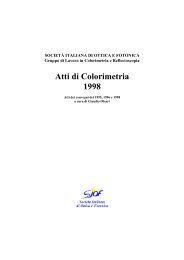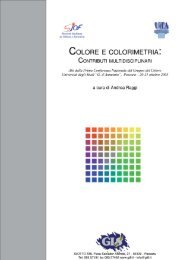Scarica gli atti - Gruppo del Colore
Scarica gli atti - Gruppo del Colore
Scarica gli atti - Gruppo del Colore
Create successful ePaper yourself
Turn your PDF publications into a flip-book with our unique Google optimized e-Paper software.
52<br />
Spectral-based printer mo<strong>del</strong>ing and characterization<br />
SILVIA ZUFFI<br />
ITC CNR, UNITÀ STACCATA DI MILANO<br />
Via Bassini, 15 – 20133 Milano, Tel. 0223699557, Fax: 0223699543<br />
zuffi@itc.cnr.it<br />
1. Introduction<br />
RAIMONDO SCHETTINI, GIANCARLO MAURI<br />
DISCO, UNIVERSITÀ DEGLI STUDI DI MILANO BICOCCA<br />
Via Bicocca de<strong>gli</strong> Arcimboldi, 8 – 20126 Milano<br />
schettini@disco.unimib.it, mauri@disco.unimib.it<br />
In image acquisition, the possibility of capturing the reflectance spectra of surfaces<br />
in a multispectral image constitutes a powerful tool for detailed and accurate color<br />
information regarding objects and scenes. In image reproduction, the multispectral<br />
approach can significantly reduce the undesirable effects of metamerism between<br />
the original and the corresponding reproduction. Most of the methods developed<br />
for the spectral-based characterization of binary printers are based on the color<br />
mixing mo<strong>del</strong> introduced by Hans Neugebauer in 1937. It assumes additive color<br />
theory, and computes the reflectance of a halftone print as the sum of each<br />
combination of inks weighted by the proportion of paper that it covers. Each ink<br />
combination is therefore a primary in the additive mo<strong>del</strong>, and is called a<br />
Neugebauer primary.<br />
Light scattering in paper causes a shadow around the edge of the dots that makes<br />
them look larger. This phenomenon, referred to as optical dot gain, was mo<strong>del</strong>ed<br />
by Yule and Nielsen with the introduction of a simple n-factor as a power function<br />
in the equation of a single color halftone, and successively applied in the<br />
Neugebauer color mixing mo<strong>del</strong>, giving the Yule-Nielsen modified Spectral<br />
Neugebauer Mo<strong>del</strong>.<br />
Much has been published on the physical grounds for the Yule Nielsen n-value. It<br />
has been observed that values between 1 and 2 are physically meaningful, and<br />
values greater than 2 represent various effects, among which the variation in dot<br />
density, and are required for high-resolution printers [1]. Usually, the n-value is<br />
treated as a free parameter to improve the mo<strong>del</strong> fit; and may be considered<br />
wavelength dependent [2].<br />
Another effect, commonly called mechanical dot gain, determines a color darker<br />
than that predicted: due to the spread of the ink on paper, the real size of a dot<br />
printed on a substrate is larger than its theoretical size. The nonlinear relationship<br />
between the theoretical concentration of ink on paper and the effective<br />
concentration (that is the area the dot actually covers), due to the combination of





